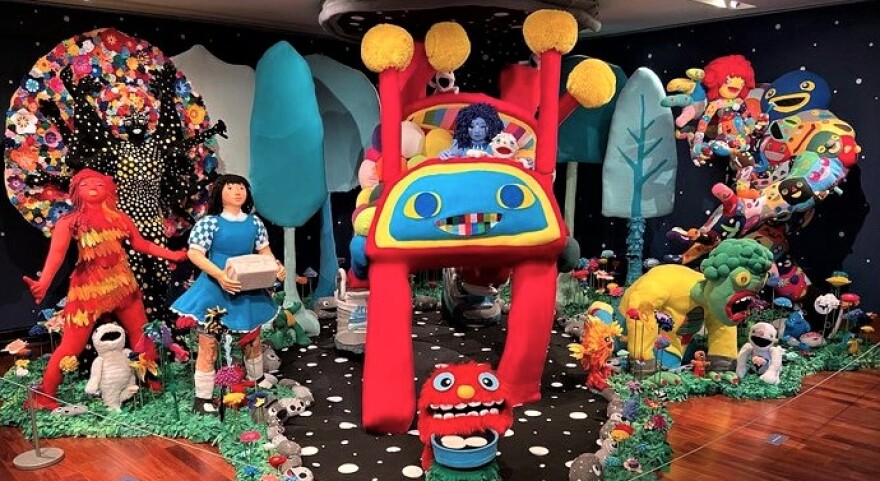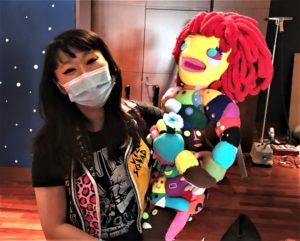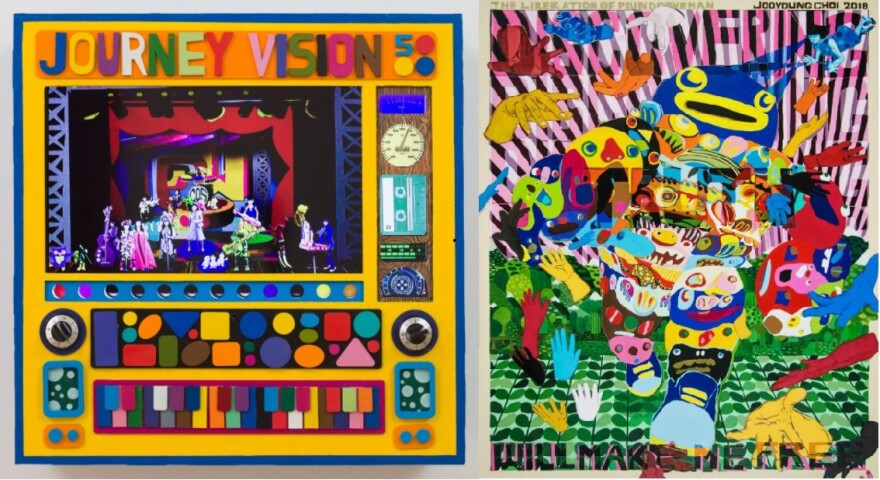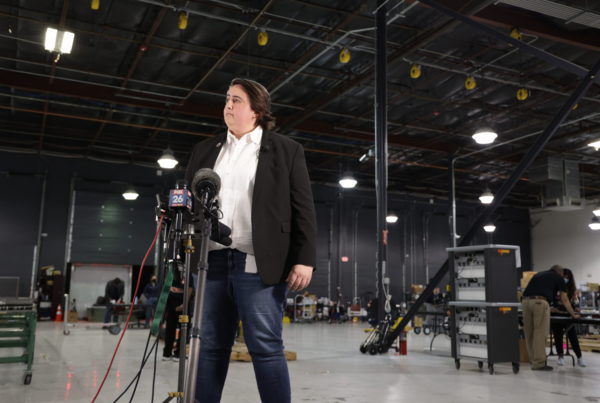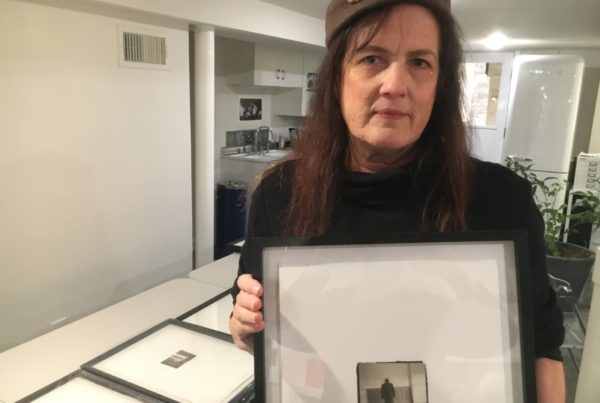From KERA:
An entire world of brightly-colored, humanoid creatures and plants, made of fabric and wood, vinyl and paint, inhabits the first-floor gallery at the Crow Museum of Asian Art.
You’d be forgiven for thinking it’s a kid’s playroom gone nuts. Walls and ceiling are painted with stars, the gallery floor is covered with smiling plants and big-eyed, pet rocks. Even though some of these stuffed animals are more than six feet tall, they still look like toys.
Amy Lewis Hofland, director of the Crow Museum, said, “As much as I hate these little signs that say, ‘Do Not Touch,’ we’re having to put those in this exhibition because you just want to hug some of her work.”
The gallery-sized installation is called Like a Bolt Out of the Blue, Faith Steps in and Sees You Through. JooYoung Choi, the artist, lives in Houston. She’s the third, Texas-based, Asian-American female artist featured by the Crow.
And if you’re familiar with Japanese animation or those big-headed, happy toys from Asian pop culture, you can see some of that in Choi’s artworks.
But Choi said her biggest influence, by far, is American-made.
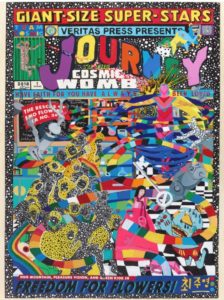
Journey to the Center of the Cosmic Womb by JooYoung Choi, acrylic paint and permalife paper on stretched canvas, 2019
“I’m a huge Marvel Comics fan, and my husband is as well,” she said. “So we’re always talking about different characters and superpowers and trying to create new characters that have powers we’ve never seen before.”
In fact, one of her acrylic paintings, Journey to the Center of the Cosmic Womb, a jazzy jumble of colors and space beings, looks very much like a vintage Fantastic Four or X-Men comic book cover – on an acid trip. And just as Marvel Comics has the Marvel Comic Universe, Choi has her own imaginary cosmos. It’s called the Wonderverse: It’s populated by her soft sculptures and puppets but also her animations and paintings on display at the Crow — in the exhibition, Songs of Resilience from the Tapestry of Faith.
Choi’s multi-dimensional new world is not all cuteness and joy. One character’s named Lady Madness, another is an “imprisoned Black Star.”
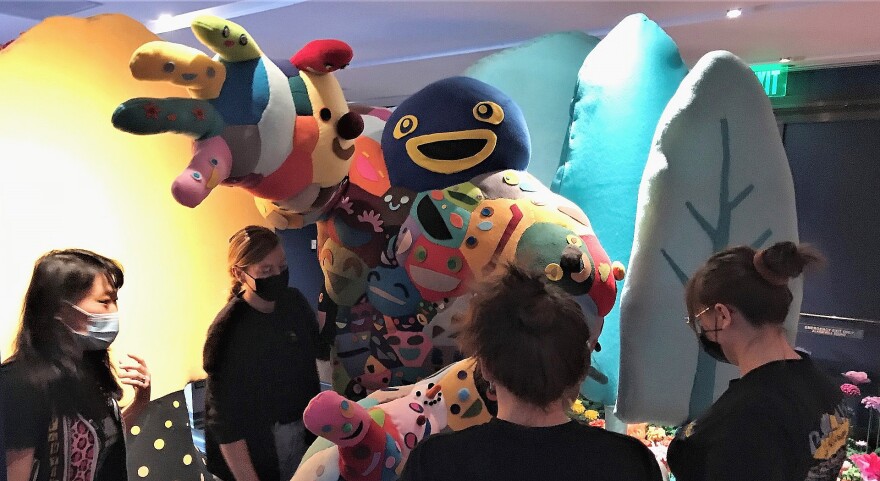
Joo Young Choi (left) and crew move Pound Cake Man into her installation at the Crow Collection
Jerome Weeks / KERA
All of Choi’s figures have elaborate interconnections. The sizable red guy in the center is a giant, four-poster bed — a bed with a face and a name: Pom Pom Thunder (hence, the big, fluffly yellow balls on top). And yes, like all Marvel superheroes, he has a very detailed backstory. Choi has worked out each character’s secret identity, group affiliation, home planet, sexual preference and so on.
“This bed is supposed to travel through time and space,” Choi said, “and reunite these different characters that lost contact with their family members in this epic war that I painted. And this character travels on a super highway of dreams and finds parents and children who’ve been dreaming about each other and reunites them.”
That story of reunited families — a story spanning planets and dreams and a lot of glue and felt — that’s pretty much the story of Choi’s own life: The 38-year-old artist was born in Korea. She was adopted as an infant, and grew up in New Hampshire.
In college, Choi went to Korea on an exchange program to study art. While there, she tracked down her birth parents. She didn’t know what to expect. After all, they had given her up — under whatever trying circumstance led them to do so. But her birth father hugged her, and with her birth parents, Choi began to piece together bits of her life — like her actual birthday.
“So I think a lot of my interest in knowing the smallest details,” Choi said, “had to do with the fact that the smallest details about my own life were missing.”
Her parents and her birthday aren’t all she discovered. Choi says, her fellow art students at Korean National University were surprised by her use of colors and compositions. Already, her early work looked traditionally Korean.
“And they said, ‘How did you know to do this?’ And it just always felt like the right decisions,” Choi said. “It definitely stemmed from a very intuitive place. And the more that I spent time with my birth family, I started to associate those colors with being near to them.”
Bridging the distance between Korea and America is an impulse in both Choi’s life and art. It’s led her to this third place, her sci-fi universe. Director Hofland says, in the cosmic interconnectedness of Choi’s work, she finds the influence of Eastern philosophy.
“I certainly see messages of compassion and inclusion in her work,” Hofland said, “which I can trace back to these precedents of Buddhism.”
But Choi says this wisdom also comes from a little world Americans know well: Mister Rogers’ Neighborhood.
Choi re-watched several seasons that she’d seen — and never fully understood — as a child.
“From there, I started reading a lot of his writings about parenting and keeping your eyes open and looking for the goodness in the world,” Choi said. “And that was very moving in a way that I had not expected. That was life-changing.”
On his TV show, Fred Rogers occasionally visited what he called the “Neighborhood of Make-Believe.” Choi’s own neighborhood of make-believe is what she calls her “journey to wholeness.”


